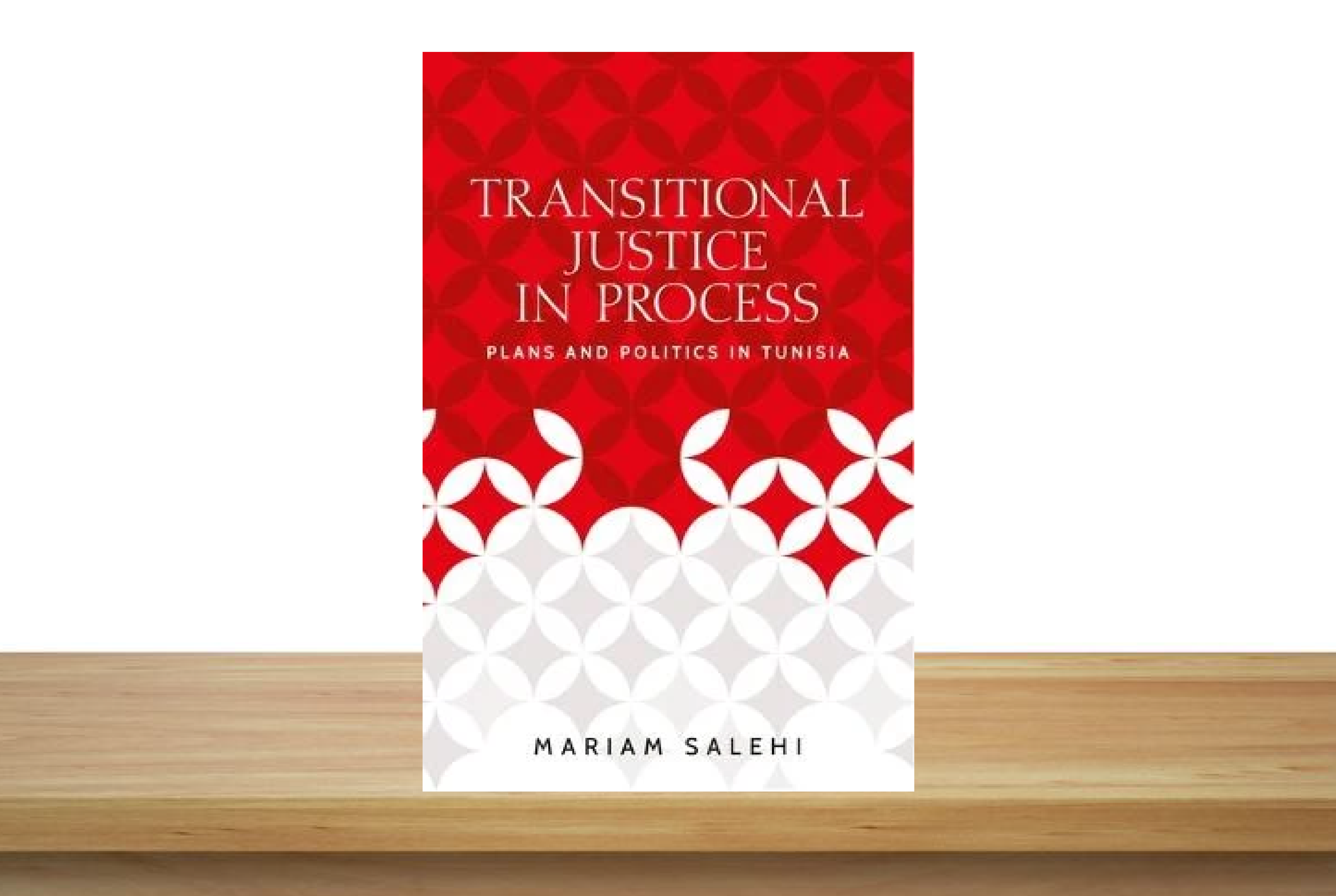“Transitional Justice in Process: Plans and Politics in Tunisia” – Book cover (Image retrieved from Manchester University Press website).
“When I returned to state affairs, this time as president, I said one must from now on look to the future.” The man who pronounced this sentence was Beji Caid Essebsi, Tunisia’s president from 2014 until his death in 2019.[i] Essebsi had powerful reasons to oppose the prospect of accountability for past misdeeds. After Tunisia became independent from France in 1956, he played a prominent role in the politics of the new state led by Habib Bourguiba. According to the Truth and Dignity Commission of Tunisia (also known by its French acronym IVD), established in 2013 following the 2010-11 Tunisian Revolution that toppled Tunisian dictator Zine El Abidine Ben Ali, Essebsi was implicated in human rights violations committed in 1963.[ii] At that time, he held the position of director of national security. Five decades later, he would become “a crucial figure preventing transitional justice.”[iii]
While for some reconciliation represents a clean slate from the past, for many it demands accountability and reparations.
Essebsi’s story encapsulates the intense contestation over the meaning of reconciliation in the post-2011 Tunisian context. While for some — like the late president himself — reconciliation represents a clean slate from the past, for many other Tunisians it demands accountability and reparations.
In her book “Transitional Justice in Process: Plans and Politics in Tunisia”, Mariam Salehi, who currently works as the leader of a research group on transnational conflict at Freie Universität Berlin, delivers a vivid portrait of transitional justice processes in the North African country over the course of the past decade. Salehi’s work combines intensive field research over several years with a solid theoretical approach. Her findings are relevant to the specific Tunisian trajectory as well as to broader debates on transitional justice and processes of social change.
Salehi broadly identifies three phases in Tunisia’s transitional justice processes. The first one started almost immediately after the departure of Ben Ali to Saudi Arabia in 2011. These initial efforts were still carried out within the old legislative and institutional framework. A second period would start in 2012 and last until 2014. It was marked by the progressive institutionalization of transitional justice and culminated with the appointment of commissioners to the IVD by the Tunisian parliament.
The third and ongoing phase began in late 2014, when the IVD started working. In 2019, the IVD published a 2,000-page report detailing a succession of human rights abuses by state institutions in Tunisia over five decades.[iv] In addition, it organized public hearings that Salehi believes “may have contributed to making the commission’s work more visible and perceived more positively.”[v] However, the specialized judicial chambers dealing with transitional justice had been slow in producing tangible results before the situation further worsened with the outbreak of the Covid-19 pandemic.
Salehi convincingly argues that transitional justice cannot be divorced from transitional politics. The politicization of such a controversial issue helps explain why interest in transitional justice does not necessarily follow a linear trajectory across time. The author identifies a declining willingness to pursue transitional justice after the 2014 electoral victory of Nida Tounes. The party, founded by Essebsi, assembles a significant number of elites from the Ben Ali dictatorship alongside groups with no ties to the former regime.
Nida Tounes’ lack of enthusiasm in transitional justice was inextricably linked to the personal trajectory of some of its members. This is different when it comes to Ennahda, the moderate Islamist party that won the first Tunisian democratic elections in 2011. Nearly 15,000 members and supporters of the party led by Rached Ghannouchi were arrested and tortured in the early 1990s.[vi] After losing support in the 2014 parliamentary elections, Ennhada joined a coalition government led by Nida Tounes in 2015 and back-pedaled on its strong support for transitional justice.
Those who had initially had an interest in seeking accountability now started collaborating with those they had wanted to see held to account.
As Salehi aptly puts it, “those who had initially had an interest in seeking accountability, and thereby excluding their opponents from the political process, now started collaborating with those they had wanted to see held to account.” [vii] The compromise can only be understood when considering the fragile political and economic situation of Tunisia at that moment, which presented a very real threat to the democratic gains achieved until then. Furthermore, Ghannouchi imposed his position on the rank-and-file members of Ennahda, who generally held less conciliatory positions. If transitional justice efforts in Tunisia managed to survive an unfriendly political climate, it was because they had “developed a limited degree of independence from shifting power structures and political preference.”[viii]
It is possible to argue that the proponents of transitional justice have sometimes been their own greatest enemies. Indeed, the task taken by the IVD upon itself was from the very beginning a gigantic one. The Organic Law on Establishing and Organizing Transitional Justice that was passed by the Tunisian National Constituent Assembly in 2013 provided not only for individuals, but also for the economically marginalized regions to be regarded as victims of the former regime. The IVD was given an extremely broad mandate in terms of the timespan and range of crimes it was asked to investigate.
The conditions in which the IVD was to perform its work were far from ideal. Its mandate lasted for only four years, and it suffered from falling political support from the parliament and limited funding, as well as from infighting within the IVD. The Tunisian approach to transitional justice was holistic in that it sought to cover many different areas. The result of this, however, was not always positive as it might intuitively appear. This is a finding that Salehi presents in the book and has examined in further detail in a recently published article, where she concludes that “the objective of pursuing as much justice as possible, and therefore addressing relevant justice problems, led to the overloading of a project limited in time, capacity, and resources.”[ix]
The reader would probably have welcomed more interview snippets in Salehi’s work. The ones that find their way into the pages of “Transitional Justice in Process” are deeply relevant as they serve to better understand the complex theoretical arguments raised by the author. Overall, Mariam Salehi has written a remarkable book that will surely become the go-to volume for anyone trying to approach the topic of transitional justice in Tunisia. After Tunisian President Kais Saied imposed himself over parliament in a coup in July 2021[x], it will be interesting to read Salehi’s analysis on the prospects of transitional justice under his authoritarian rule. The current situation is deeply concerning, especially after Saied dissolved last February the Supreme Judicial Council, one of the few remaining institutions able to act as a counter-power.[xi]
[i] Overdahl, Stian. “Can Tunisia Break With Its Past?” Zenith, November 22, 2017. https://magazine.zenith.me/en/business/economic-effects-transitional-justice.
[ii] Blaise, Lilia, and Carlotta Gall. “Béji Caïd Essebsi, President Who Guided Tunisia to Democracy, Dies at 92.” The New York Times, July 25, 2019. https://www.nytimes.com/2019/07/25/world/africa/beji-caid-essebsi-tunisia-dead.html.
[iii] Bishara, Azmi. Understanding Revolutions: Opening Acts in Tunisia (London: I.B. Tauris, 2021), p. 272.
[iv] Blaise, Lilia. “Tunisia Commission Releases Final Report on 50 Years of Dictatorship.” The New York Times, March 28, 2019. https://www.nytimes.com/2019/03/28/world/africa/tunisia-president-commission-report.html.
[v] Salehi, Mariam. Transitional Justice in Process: Plans and Politics in Tunisia (Manchester: Manchester University Press, 2022), p. 146.
[vi] International Crisis Group. “Tunisia: Transitional Justice and the Fight Against Corruption.” Middle East and North Africa Report (Tunis/Brussels: International Crisis Group, May 2016), p. 3. Retrieved from: https://www.crisisgroup.org/middle-east-north-africa/north-africa/tunisia/tunisia-transitional-justice-and-fight-against-corruption.
[vii] Salehi, Transitional Justice in Process: Plans and Politics in Tunisia, p. 140.
[viii] Ibid., p. 171.
[ix] Salehi, Mariam. “Trying Just Enough or Promising Too Much? The Problem-Capacity-Nexus in Tunisia’s Transitional Justice Process.” Journal of Intervention and Statebuilding 16, no. 1 (2022): 98–116.
[x] Megerisi, Tarek. “Tunisia Coup: What Europeans Can Do to Save North Africa’s Only Democracy.” European Council on Foreign Relations, July 26, 2021. https://ecfr.eu/article/tunisia-coup-what-europeans-can-do-to-save-north-africas-only-democracy/.
[xi] Al-Jazeera. “Tunisia Police Lock Doors of Legal Body, Stop Staff from Entering.” Al Jazeera, February 2, 2022. https://www.aljazeera.com/news/2022/2/7/tunisia-top-legal-body-turns-against-saeid.

















